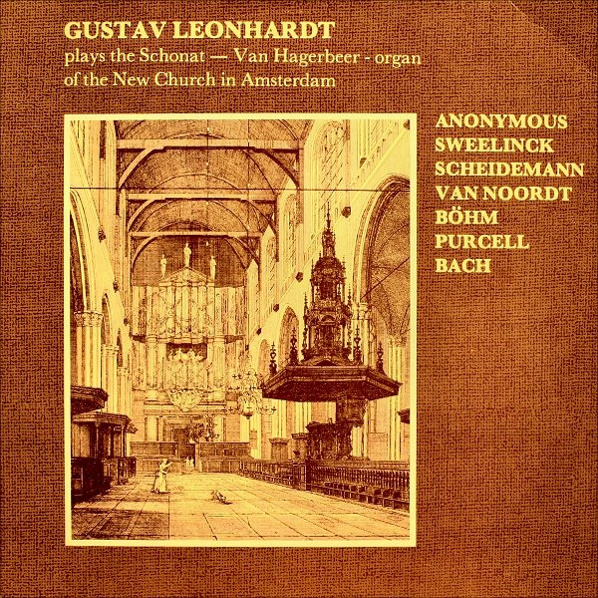 |
1 LP -
6814 594 - (p) 1987
|
|
SCHONAT-VAN
HAGERBEER - ORGAN OF THE NEW CHURCH IN
AMSTERDAM
|
|
|
|
|
|
|
|
| Anonymous
(Dutch ca. 1625) |
Psalm
23 (3 variations) |
|
--' --" |
A1 |
| Heinrich SCHEIDEMANN
(c.1596-1663) |
Praeludium
VI |
|
--' --" |
A2
|
| Anonymous (Dutch ca.
1650) |
3 variations on "Daphne" |
|
--' --" |
A3
|
| Jan Pieterszoon
SWEELINCK (1562-1621) |
Ballo
del Granduca
|
|
--' --" |
A4 |
| Anthoni van NOORDT (1664-1673)
|
Fantasia
in d minor (Amsterdam 1659) |
|
--' --" |
A5 |
| Johann Sebastian BACH
(1685-1750) |
"Komm
Gott, Schöpfer, Heil' ger Geist",
BWV 667
|
|
--' --" |
B1 |
| Georg BÖHM
(1661-1733) |
"Christum
wir sollen loben schon" |
|
--' --" |
B2 |
| Henry PURCELL
(c.1658-1695) |
Voluntary
for the double organ |
|
--' --" |
B3 |
|
Voluntary
in G major |
|
--' --" |
B4 |
| Johann Sebastian BACH
|
Praeludium
et Fuga in e minor, BWV 533 |
|
--' --" |
B5 |
|
|
|
|
|
| Gustav
Leonhardt, Organ
(Schonat-Van Hagerbeer-organ of the New
Church in Amsterdam) |
|
|
|
|
|
Luogo
e data di registrazione |
|
Nieuwe Kerk,
Amsterdam (Holland) - 1987
|
|
|
Registrazione: live
/ studio |
|
studio |
|
|
Producer /
Recording Supervisor |
|
Stichting de Nieuwe
Kerk, Amsterdam
|
|
|
Recording Engineer
|
|
-
|
|
|
Prima Edizione LP |
|
Stichting Nieuwe Kerk
| 6814 594 | 1 LP - durata 41' 45"
| (p) 1987 | ANA
|
|
|
Edizione CD |
|
Nessuna
|
|
|
Original Cover
|
|
-
|
|
|
Note |
|
Nationale Stichting
de Nieuwe Kerk - P.O. Box 3438 -
1001 AE Amsterdam
|
|
|
|
|
|
The Great Organ,
situated at the west end of
the New Church, is the work
of Johann Wolfgang Schonat
of Kitzingern/Main (W.
Germany).
The imposing structure was
designed by Jacob van
Campen, the famous architect
of the Town Hall. The
Rückpositiv, the
Pedal-towers as well as the
Great are provided with
shutters, decorated with
paintings by Jan Gerritsz.
van Bronckhost. The work has
been executed between 1650
and 1655.
Jacobus Galtusz. van
Hagerbeer enlarged in
1668-1673 the organ
considerably by adding a
third manual (Oberwerk) and
6 extra stops in the
Rückpositiv. Van Hagerbeer
died during the work in
1670. His foreman Roelof
Barentsz Duyschot and his
son Johannes finisched the
job in 1673. When the organ
was completed, it had 43
stops, 10 spring-chestes, 3
slider-chests and 8 bellows.
During the 18th. entury only
unimportant reparations were
carried out.The
organ-builders Bätz and Co.
of Utrecht restored the
instrument in 1838-40. They
removed the double ranks of
many stops. In the Oberwerk
a Viola da gamba 8 ft.
replaced the Scherp. The
pedal-stops Quint 3 ft. and
Mixture were replaced with a
Roerquint 6 ft. and a
Trumpet 4 ft. Bätz enlarged
the Hauptwerk by adding a
Dulciaan 16 ft. and a
Trumpet 8 ft. Many pipes
were shifted and provided
with tuning slides. Bätz
also renewed the key-boards
and couplers.
In 1912 the oran-builder
Maarschalkerweerd of Utrecht
replaced the 8 original,
single-rise, diagonal
bellows by reservoir
bellows. The sesquialtera in
the Oberwerk and the scherp
in the Hauptwerk were
replaced by a Roerfluit 4
ft. and a Flute 2 ft.
In 1977-81 the organ has
been most conscientiously
restored by Marcussen &
Son of Aabenraa (Denmark),
The Great Organ of the New
Church in Amsterdam is one
of the most important
historic instruments in the
Low Countries.
The organ now has 48 stops
and 5005 speaking pipes. It
is the best preserved organ
with spring-chests in
Europe.
|
  |
|
|